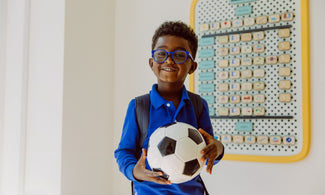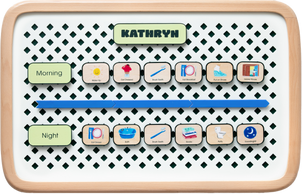Goodbye Summer, Hello Fall: 5 Tips to Transition Back to School

No matter how much family fun you’ve managed to squeeze into summer, preparing for a new school year is always bittersweet. It’s easy to get wrapped up in back-to-school details like shopping for supplies and organizing after school activities. Your Springboard can help you put down the to-do list (yes, really!) and deliver what your family truly needs during this hectic time. Here are a few strategies to help you navigate the first couple months of the new school year!
Create Routine Together
Children are constantly looking to us for information, especially when it comes to new people, places and routines. Use your Springboard to help your child understand their new back to school routine. Invite your child to set up the routine with you. As you add tiles, talk through questions about what will happen before they leave for school, what the day at school will look like and what happens when the school day is done. Show your child that you’re comfortable discussing back-to-school details by asking, “Do you have any questions about what school will be like?” If you don’t have the answer that your child is seeking, investigate together! “Hmm… I’m not sure if your class will have outdoor time with Parker’s class this year. Last year, every classroom had their own, separate outdoor time. Let’s ask your teacher when we visit your classroom next week.”
Minimize Morning Madness
Your Springboard will help your child to visualize their getting ready process, which sets expectations and invites them to take on tasks with more independence (and less nagging!). Be mindful of what your child can see and hear from their “getting-ready spot”. Try turning the TV off or encouraging your child to get dressed in your bedroom, away from enticing toys. If you have more than one child, they may respond well to separate getting-ready spots in your home. If your child gets distracted along the way, refer back to their Springboard to bring their attention to a specific task, “It’s time to focus on getting your shoes on now.”
Connect Daily
Introduce a daily ritual that inspires your family to connect. Look at the Springboard Tiles in your child’s routine. When are you most likely to be in the same place at the same time? Dinner time works for some families, but bedtime may be a better, more realistic fit. Challenge yourself to be fully present and model active listening by shutting TVs off and placing phones out of sight. Choose a practice that feels right for your family. Here are a few of our faves:
Take turns sharing the very best part of your day.
Discuss your daily “low” and “high”.
Identify a “thorn” (negative moment), “rose” (positive moment) and “bud” (something you are looking forward to).
Share your proudest moment of the day, as well as something you’d like to do differently tomorrow.
Build Independence
Help your child learn to use the Springboard as a tool for independently getting answers about their day. If your child says, “What am I doing after school today?” invite them to look at their Springboard to get the answer. This will help them understand that they can use their Springboard at any time to make sense of what is happening or what is going to happen, which is incredibly comforting for children during times of transition.
Prioritize Play
Reach for that Play Tile! It can be tempting to over-schedule your child, especially when you hear about the impressive after school activities your friends have lined up for their own children. How busy is too busy? If you can, be sure that your child has at least 30 minutes of uninterrupted play per day. Experiment with when you add Play to your family’s daily routine by observing your child and trying to follow their lead. They may benefit from morning play sessions as they prepare for the day ahead. Many children also crave independent play when they return home from school, as it helps them process all that they’ve experienced.
